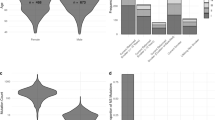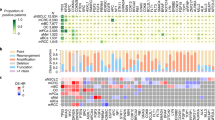Abstract
Delivering on the promise of personalized medicine has become a focus of the pharmaceutical industry as the era of the blockbuster drug is fading. Central to realizing this promise is the need for improved analytical strategies for effectively integrating information across various biological assays (for example, copy number variation and targeted protein expression) toward identification of a treatment-specific subgroup—identifying the right patients. We propose a novel combination of elastic net followed by a maximal χ2 and semiparametric bootstrap. The combined approaches are presented in a two-stage strategy that estimates patient-specific multi-marker molecular signatures (MMMS) to identify and directly test for a biomarker-driven subgroup with enhanced treatment effect. This flexible strategy provides for incorporation of business-specific needs, such as confining the search space to a subgroup size that is commercially viable, ultimately resulting in actionable information for use in empirically based decision making.
This is a preview of subscription content, access via your institution
Access options
Subscribe to this journal
Receive 6 print issues and online access
$259.00 per year
only $43.17 per issue
Buy this article
- Purchase on Springer Link
- Instant access to full article PDF
Prices may be subject to local taxes which are calculated during checkout




Similar content being viewed by others
References
Foster JC, Taylor JMG, Ruberg SJ . Subgroup identification from randomized clinical trial data. Stat Med 2011; 30: 2867–2880.
Lipkovich I, Dmitrienko A, Denne J, Enas G . Subgroup identification based on differential effect search—A recursive partitioning method for establishing response to treatment in patient subpopulations. Stat Med 2011; 30: 2601–2621.
Kehl V, Ulm K . Responder identification in clinical trials with censored data. Comput Stat Data An 2006; 50: 1338–1355.
Miller R, Siegmund D . Maximally selected chi square statistics. Biometrics 1982; 38: 1011–1016.
Halpern J . Maximally selected chi square statistics for small samples. Biometrics 1982; 38: 1017–1023.
US Department of Health and Human Services. Draft Guidance for Industry, Clinical Laboratories, and Staff: In Vitro Diagnostic Multivariate Index Assays. Accessed online on 15 February 2013 at http://www.fda.gov/downloads/MedicalDevices/DeviceRegulationandGuidance/GuidanceDocuments/ucm071455.pdf.
Woodcock J, Repoli A, Lebowitz MS The Development, Validation, and Clinical Utility of our Multiplex Biomarker Panel for the Early Detection of Lung Cancer 2013. http://genesysbiolabs.com/wp-content/uploads/2012/03/Validation-Report-March-2012.pdf.
Curtis JR, van der Helm-van Mil AH, Knevel R, Huizinga TW, Haney DJ, Shen Y et al. Validation of a novel multi-biomarker test to assess rheumatoid arthritis disease activity. Arthrit Care Res 2012; 64: 1794–1803.
Cai T, Tian L, Wong PH, Wei LJ . Analysis of randomized comparative clinical trial data for personalized treatment selections. Biostatistics 2011; 12: 270–282.
Cox DR . Regression models and life-tables. J Roy Stat Soc B 1972; 34: 187–220.
Friedman J, Hastie T, Tibshirani R . Regularization paths for generalized linear models via coordinate descent. J Stat Softw 2010; 33: 1–22.
Simon N, Friedman J, Hastie T, Tibshirani R . Regularization paths for Cox's proportional hazards model via coordinate descent. J Stat Softw 2011; 39: 1–13.
Anderson MJ . Permutation tests for univariate or multivariate analysis of variance and regression. Can J Fish Aquat Sci 2001; 58: 626–639.
Casellas J, Tarrés J, Piedrafita J, Varona L . Parametric bootstrap for testing model fitting in the proportional hazards framework: an application to the survival analysis of Bruna dels Pirineus beef calves. J Anim Sci 2006; 84: 2609–2616.
Bůžková P, Lumley T, Rice K . Permutation and parametric bootstrap tests for gene-gene and gene-environment interactions. Ann Hum Genet 2011; 75: 36–45.
Zou H, Hastie T . Regularization and variable selection via the elastic net. J R Stat Soc B 2005; 67: 301–320.
Wu TT, Chen YF, Hastie T, Sobel E, Lange K . Genome-wide association analysis by lasso penalized logistic regression. Bioinformatics 2009; 25: 714–721.
Fan J, Lv J . Sure independence screening for ultrahigh dimensional feature space. J R Stat Soc B 2008; 70: 849–911.
Meinshausen N, Bühlmann P . Stability selection. J R Stat Soc B 2010; 72: 417–473.
Li Y, Willer C, Sanna S, Abecasis G . Genotype imputation. Annu Rev Genomics Hum Genet 2009; 10: 387–406.
Acknowledgements
We acknowledge and thank Stewart Fossceco, Lei Shen and the reviewers for their critical and in-depth review of the manuscript as well as Dilan C Paranagama for his contributions to the implementation of the methodology and simulation studies.
Author information
Authors and Affiliations
Corresponding author
Ethics declarations
Competing interests
This study results from the employment of all authors by BioStat Solutions, Inc. (BSSI) and Eli Lilly and Company.
Additional information
Supplementary Information accompanies the paper on the The Pharmacogenomics Journal website
Supplementary information
Rights and permissions
About this article
Cite this article
Li, L., Guennel, T., Marshall, S. et al. A multi-marker molecular signature approach for treatment-specific subgroup identification with survival outcomes. Pharmacogenomics J 14, 439–445 (2014). https://doi.org/10.1038/tpj.2014.9
Received:
Revised:
Accepted:
Published:
Issue Date:
DOI: https://doi.org/10.1038/tpj.2014.9



